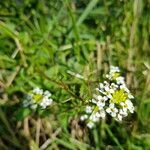A cabbage family herb. It is similar to watercress. It keeps growing from year to year. The stems are hollow. They root at the nodes. The flowers are in clusters on the ends of shoots. The flowers are white and have 4 petals. The fruit are more narrow and 15-22 mm long.





